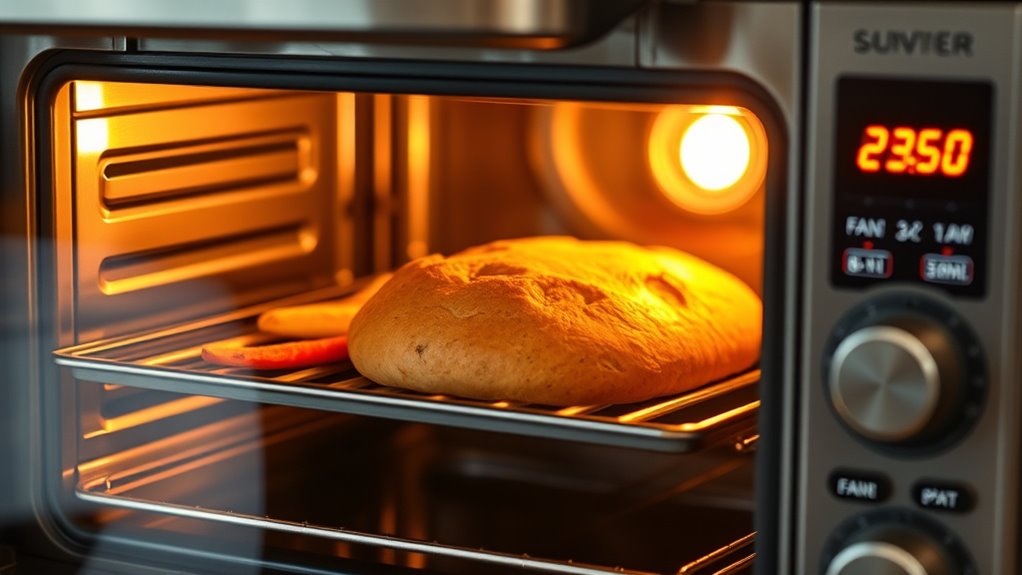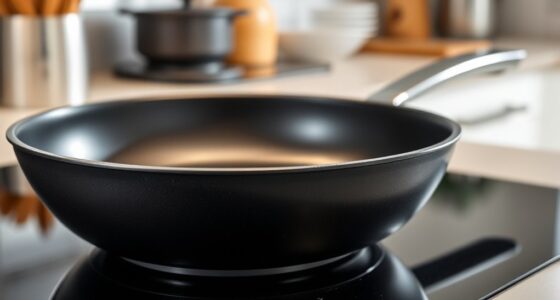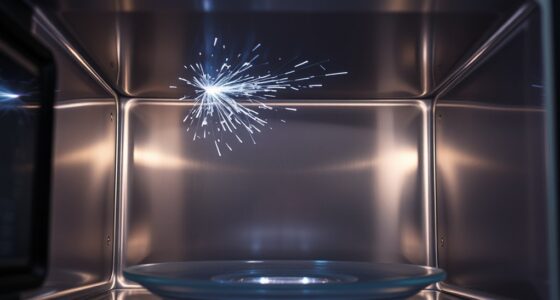To use a convection oven for baking and roasting, start by reducing your recipe’s temperature by 25°F and cut cooking time by about 25%. Preheat thoroughly and position racks properly for even airflow. Maintain the fan at medium or high speed and avoid overcrowding to promote crisp, golden results. Keep an eye on your food’s progress, adjust as needed, and guarantee proper maintenance. For detailed tips, keep exploring further.
Key Takeaways
- Reduce recipe temperature by 25°F and cooking time by about 25% to adapt for convection heat circulation.
- Position racks properly, leaving space around food for even airflow, and rotate trays during baking.
- Set the fan to medium or high speed and avoid blocking vents to optimize heat transfer.
- Use metal bakeware for better heat conduction and achieve crispy, evenly baked results.
- Monitor food closely with visual cues and internal thermometers to prevent over- or undercooking.
Understanding How Convection Ovens Work

Convection ovens work by circulating hot air around your food, which helps it cook more evenly and quickly. This relies on convection principles, where the movement of heated air transfers heat efficiently. Airflow dynamics play a vital role in this process; the oven’s fan forces hot air to flow continuously over the food, eliminating cold spots and promoting uniform cooking. The design ensures that the heat is distributed consistently, reducing cooking times and improving browning. Understanding how the airflow moves within the oven allows you to optimize cooking results. Unlike traditional ovens, where heat rises and can create uneven temperatures, convection ovens actively manage airflow to maintain a steady, even temperature throughout. This precise control is what makes convection cooking faster and more reliable. Additionally, air circulation is essential for achieving optimal browning and crispy textures on your dishes. Mastering airflow patterns can help you fine-tune your cooking techniques for better results, especially since proper airflow can influence heat transfer efficiency. Effective airflow control is key to maximizing the benefits of convection cooking and achieving consistently excellent results.
Adjusting Recipes for Convection Cooking
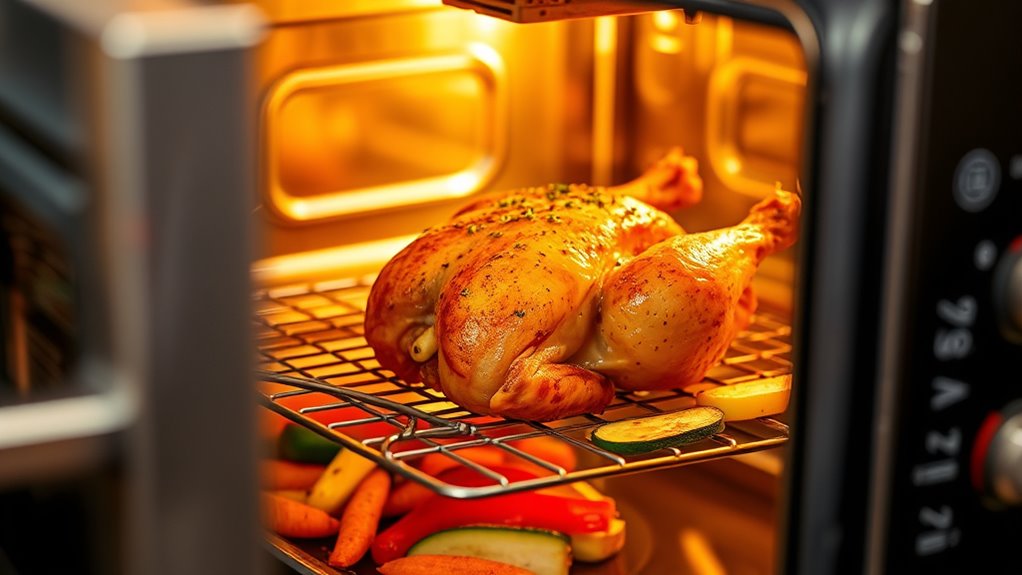
Since convection ovens cook food faster and more evenly, you’ll need to modify your recipes accordingly. This means making recipe modifications such as reducing cooking times by about 25% and lowering the temperature by 25°F to prevent overcooking. When substituting ingredients, consider how the faster heat circulation affects moisture and texture; for example, delicate items like soufflés may need shorter baking times. It’s also wise to monitor your food closely the first few times you use convection, making adjustments as needed. Keep in mind that ingredient substitutions, such as replacing butter with oil or using low-fat alternatives, can influence cooking times and browning. Additionally, proper oven calibration can help ensure your convection oven operates accurately, leading to better results. Regular calibration can compensate for oven temperature inaccuracies, ensuring your recipes turn out as intended. Understanding thermal behavior in convection cooking can further enhance your baking and roasting precision. Mastering heat circulation can optimize your cooking outcomes in convection ovens. Plus, outdoor kitchen setups can be designed to incorporate convection ovens effectively, enhancing your baking and roasting experience. By tweaking recipes thoughtfully, you’ll ensure consistent, delicious results in your convection oven.
Properly Positioning Racks and Food Items

To get the best results, you need to place your racks and food items correctly in your convection oven. Proper rack placement guarantees even heat circulation, so your dishes cook uniformly. Remember to space food items adequately to prevent overcrowding and promote proper airflow. Maintaining a calm and organized approach to your oven setup helps ensure consistent cooking outcomes.
Optimal Rack Placement
Proper rack placement is essential for ensuring even cooking and ideal airflow in your convection oven. To achieve this, focus on rack positioning by selecting the right oven rack levels for your recipe. For roasting large cuts or multiple items, position the rack in the middle to allow hot air to circulate freely around the food. When baking cookies or small baked goods, placing the rack in the upper or lower third can promote even browning. Avoid overcrowding by leaving space between items to allow proper airflow. Adjust the rack levels based on the size and type of food you’re preparing, ensuring heat reaches all sides evenly. Correct rack placement helps you get consistent, professional results every time. Additionally, understanding oven airflow can help you optimize your rack placement for better cooking performance. Proper wall surface maintenance and ventilation can also enhance your oven’s efficiency and safety. Regularly cleaning your oven and ensuring proper ventilation can improve airflow and cooking results. Incorporating airflow optimization techniques can further improve your baking and roasting outcomes. Paying attention to air circulation within the oven can help prevent hot spots and ensure uniform cooking.
Food Spacing Essentials
Properly spacing your food items and racks is essential for even cooking in a convection oven. Follow spacing guidelines to ensure hot air circulates freely around each item. Keep food placement at least one to two inches apart, avoiding overcrowding. This allows heat and airflow to reach all surfaces, promoting uniform browning and thorough cooking. When roasting or baking multiple items, position racks so that air can flow evenly between them, and rotate trays if needed. Use the oven’s rack positions to optimize heat distribution, placing larger or denser foods on lower racks. Additionally, understanding free floating principles can help in designing a backyard space that maximizes airflow and natural ventilation around your oven setup. By adhering to these spacing guidelines, you’ll prevent steaming or uneven cooking, resulting in perfectly baked or roasted dishes with consistent results. Proper food placement is key to leveraging your convection oven’s full potential.
Setting the Right Temperature and Time

Setting the right temperature and time is essential for achieving perfect results with your convection oven. First, verify your oven’s temperature calibration is accurate, as convection ovens can sometimes run hot or cold. Always preheat your oven to the desired temperature before baking or roasting; this guarantees consistent cooking. When adjusting recipes, remember that convection ovens typically require lowering the temperature by about 25°F (15°C) compared to conventional ovens. Use a reliable oven thermometer to verify accuracy. Keep an eye on the cooking time, as convection heat tends to cook food faster. Avoid opening the door frequently, which can cause temperature fluctuations. Proper temperature calibration and preheating help you achieve even, thorough cooking every time.
Using the Convection Fan Effectively

Once you’ve adjusted your oven’s temperature and preheated it correctly, making the most of the convection fan can substantially improve your cooking results. Set the fan speed to a medium or high setting for even heat circulation, which helps food cook faster and more uniformly. Pay attention to the airflow direction—most convection ovens allow you to control or influence it. Keep the fan centered for balanced air distribution, or adjust if your oven has multiple settings. Proper airflow ensures heat reaches all sides of your dish, preventing hot spots and uneven browning. Avoid blocking the vents or crowding the oven, as this can disrupt airflow. Using the convection fan effectively means fine-tuning fan speed and airflow direction for ideal baking and roasting outcomes. Proper airflow management enhances the efficiency of convection cooking, ensuring consistent and perfect results. Additionally, understanding how to convection oven settings can help you optimize performance based on the specific dish you’re preparing. Adjusting airflow patterns based on the dish type can further improve overall results.
Choosing the Best Bakeware for Convection

Choosing the right bakeware is essential for maximizing the benefits of convection cooking, as it influences heat distribution and browning. Opt for bakeware materials like metal, which conduct heat evenly and promote crisp, golden results. Avoid glass or ceramic containers unless they’re labeled oven safe, as they can insulate and slow heat transfer, leading to uneven cooking. Shiny, reflective surfaces help bounce heat and improve browning, while darker pans absorb heat better, speeding up baking time. Use oven safe containers designed for high temperatures to prevent warping or breaking. Proper bakeware ensures your food cooks evenly and achieves the desired texture. Selecting the appropriate materials and oven safe containers makes a significant difference in convection baking success. Nanotechnology advancements are also being explored to develop innovative bakeware with enhanced heat conduction properties, further improving baking outcomes. Additionally, understanding heat transfer methods can help you choose the most suitable bakeware for your specific recipes. Incorporating proper bakeware maintenance can also extend the lifespan and performance of your bakeware, ensuring consistent results over time.
Monitoring Food for Perfect Results

To get perfect results, keep an eye on your food using visual cues like browning and bubbling. Check internal temperatures with a thermometer to make certain doneness without overcooking. If needed, adjust your cooking time to account for the convection oven’s efficiency and your specific recipe.
Use Visual Cues
Monitoring your food visually is essential for achieving perfect results in a convection oven. Pay close attention to color cues; a golden-brown crust often signals doneness, while over-browning may indicate it’s time to remove the dish. Texture indicators are equally important—look for a firm, crisp exterior on baked goods and a tender, juicy interior on roasts. These visual signs help you judge doneness without relying solely on timers. Keep an eye on the edges and surfaces, as convection heat can cause uneven coloring if not monitored. By observing these cues, you can prevent overcooking or undercooking, ensuring your food turns out perfectly every time. Trust your eyes to guide you for ideal baking and roasting results, as understanding visual cues is key to mastering convection cooking.
Check Internal Temperatures
Checking internal temperatures is the most reliable way to guarantee your food is perfectly cooked. Use a digital meat thermometer to monitor meat doneness and ensure it reaches the recommended temperature for safety and quality. For baked goods, a probe thermometer can help verify that your items have achieved the correct internal baking temperature, preventing under- or overcooking. Insert the thermometer into the thickest part of the meat or the center of baked goods for accurate readings. Remember, convection ovens often cook faster and more evenly, so checking internal temperatures prevents overcooking. Keep a close eye on your food’s internal temperature, especially when roasting meats or baking delicate items, to achieve consistent, delicious results every time.
Adjust Cooking Time
Since internal temperatures can vary based on factors like oven performance and food thickness, adjusting cooking time is key to achieving perfect results. When using a convection oven, you may need to modify the cooking duration for different recipes. Keep an eye on your food and start checking for doneness a few minutes earlier than the recipe suggests. This helps prevent overcooking, especially since convection heat cooks more efficiently. You might need to make recipe adaptations, like reducing cooking time or lowering the temperature slightly. Monitoring your food closely allows you to fine-tune the cooking duration, ensuring it’s cooked thoroughly without drying out. With practice, you’ll develop a sense for how long your dishes take, leading to consistently better baking and roasting results.
Tips for Achieving Crispy and Evenly Baked Goods
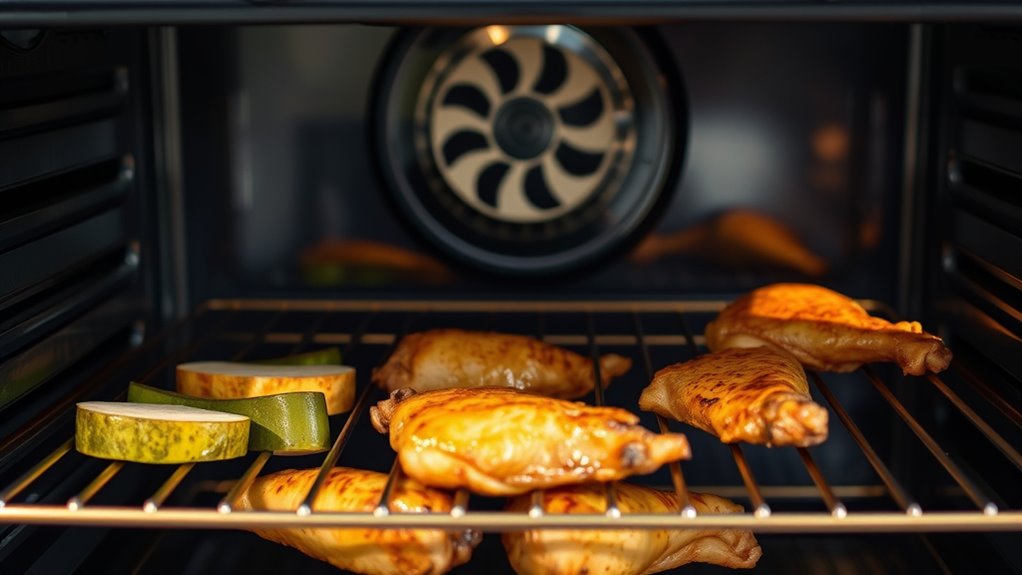
To achieve crispy and evenly baked goods in a convection oven, you need to pay close attention to temperature and placement. Use a proper baking surface, such as a wire rack or perforated tray, to allow hot air circulation, which promotes crispiness. Avoid overcrowding the oven, as crowded pans block even heat distribution. For flavor enhancement, consider using a light coating of oil or butter on your baked goods to encourage browning and crispness. Rotating your pans halfway through baking also helps ensure even results. Keep an eye on your oven’s temperature settings; slightly lower temperatures can prevent burning while still achieving that perfect crunch. Proper placement and attention to your baking surface are key to consistently delicious, crispy, and evenly baked treats.
Cleaning and Maintaining Your Convection Oven

Maintaining a clean convection oven guarantees your baked goods come out perfect every time and helps extend the appliance’s lifespan. Regular cleaning tips include wiping down the interior after use with a damp cloth and removing any spills or food debris promptly. Use a gentle cleaner or a mixture of baking soda and water for stubborn stains. Keep the oven’s vents and fans free of dust and grease to guarantee ideal airflow. Follow maintenance routines such as inspecting door seals for wear and replacing them if needed, and checking that heating elements are functioning correctly. Avoid harsh abrasives that could damage surfaces. Consistent cleaning and routine upkeep keep your convection oven running efficiently, reduce fire hazards, and ensure your baked creations come out flawless.
Troubleshooting Common Convection Cooking Issues

Even the best convection ovens can run into common issues that disrupt cooking performance. If your dishes aren’t cooking evenly, check your oven calibration; an uncalibrated oven can cause temperature inconsistencies. Adjustments might be necessary to guarantee accurate heat distribution. If your baked goods are browning too quickly or not enough, consider recipe modifications like reducing temperature or cooking time. Uneven results may also stem from overcrowding or improper rack placement, so give your food space to circulate air freely. Additionally, ensure your oven’s fan is functioning correctly. Addressing these issues helps optimize convection cooking. Regularly calibrating your oven and tweaking recipes based on your specific appliance can prevent many common problems and improve overall results.
Frequently Asked Questions
Can I Use Aluminum Foil Safely in a Convection Oven?
Yes, you can use aluminum foil safely in a convection oven, but make sure to adhere to aluminum foil safety guidelines. Avoid covering the entire rack or blocking air vents, as this can hinder airflow and affect cooking. If you’re concerned about foil safety, consider foil alternatives like parchment paper or silicone baking mats. These options help prevent foil-related issues and ensure even heat distribution during baking and roasting.
How Do I Prevent Food From Drying Out During Convection Cooking?
To prevent food from drying out during convection cooking, focus on moisture retention by using proper cooking techniques. Cover dishes with foil or a lid to trap steam, and baste meats regularly to keep them moist. Adjust cooking times and temperatures slightly lower than traditional methods, and consider adding a water pan in the oven to maintain humidity. These tips help your food stay tender and flavorful.
Is It Necessary to Preheat the Oven Every Time?
They say “better safe than sorry,” and that’s true for preheating your convection oven. Preheating isn’t always necessary, but it helps guarantee oven temperature consistency and even cooking. For most recipes, preheat for 10-15 minutes to reach the right temperature. If you’re roasting or baking delicate items, preheating becomes more important. Skipping it may result in uneven cooking or longer cooking times, so when in doubt, preheat!
Can I Bake Different Items Simultaneously Without Flavor Transfer?
Yes, you can bake different items simultaneously without flavor transfer by using proper techniques. To minimize cross contamination concerns and prevent flavor crossover, place baked goods in separate, well-sealed pans or use parchment paper between items. Keep a safe distance between the trays, and consider rotating them during baking. These steps help maintain individual flavors and ensure each item turns out perfectly.
How Do I Convert Traditional Oven Recipes for Convection Use?
Think of your oven as a symphony; each instrument needs to be tuned differently. To convert traditional recipes for convection use, you should reduce the temperature by about 25°F and check for doneness earlier. Make recipe adjustments by lowering cooking times and adjusting ingredients if needed. This way, your baked goods will come out perfectly, with even browning and consistent texture, just like a well-conducted orchestra.
Conclusion
Mastering your convection oven is like learning a subtle dance—you’ll find the rhythm that brings out the best in your dishes. With patience and a keen eye, you’ll turn everyday ingredients into culinary delights. Embrace the gentle nuances of convection cooking, and soon, your kitchen will become a haven for crispy, evenly baked wonders. Trust the process, and let your oven’s quiet sophistication elevate every meal you create.
